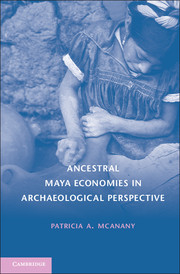Book contents
- Frontmatter
- Dedication
- Contents
- List of Figures
- Preface and Acknowledgments
- 1 The Materiality of Practice in Ancestral Maya Economies
- 2 Situating Maya Societies in Space and Time
- 3 Feeding a Hungry Landscape
- 4 Gendered Labor and Socially Constructed Space
- 5 Ritual Works: Monumental Architecture and Generative Schemes of Power
- 6 Naturalized Authority of the Royal Court
- 7 Social Identity and the Daily Practice of Artisan Production
- 8 Places, Practices, and People of Commerce
- 9 Flowery Speech of Maya Tributary Arrangements
- 10 Skeining the Threads
- References Cited
- Index
3 - Feeding a Hungry Landscape
Published online by Cambridge University Press: 05 December 2014
- Frontmatter
- Dedication
- Contents
- List of Figures
- Preface and Acknowledgments
- 1 The Materiality of Practice in Ancestral Maya Economies
- 2 Situating Maya Societies in Space and Time
- 3 Feeding a Hungry Landscape
- 4 Gendered Labor and Socially Constructed Space
- 5 Ritual Works: Monumental Architecture and Generative Schemes of Power
- 6 Naturalized Authority of the Royal Court
- 7 Social Identity and the Daily Practice of Artisan Production
- 8 Places, Practices, and People of Commerce
- 9 Flowery Speech of Maya Tributary Arrangements
- 10 Skeining the Threads
- References Cited
- Index
Summary
In archaeological monographs, it is common practice to preface survey or excavation descriptions with a section entitled “environmental setting” in order to set the stage for the cultural material to be presented. Historically, the “give-and-take” between environment and culture, in “settlement-pattern/processualist” terms, was perceived in terms of the environment doing the “giving” or setting the terms of interaction and the culture doing the “taking” or responding to the terms or limitations imposed by the environment (see Trigger 1989 :303–311 for extended discussion). Under the rubric of “cultural ecology” (Steward 1955:30–42), this trend continued, but more recently “historical ecology” has promoted a more nuanced modeling of this interaction (Balée 1998; Balée and Erickson 2006 ; Bilsky 1980 ; Crumley 1994 ; Crumley et al. 2001). Within the earlier cultural ecology frame, economy was restricted to the methods by which an environment was managed and labor organized to extract and distribute resources. If one employs such a segmental perspective, nothing could be farther from ritual practice than economic behavior (see Isaac 1993:465 for more on this topic). According to Hawkes's (1954) fabled ladder of inference, archaeological economies were knowable whereas anything to do with ideology required a great inferential leap. Here, we diverge from this epistemology but not before tacking across these well-traveled waters.
The advent of landscape studies - although rooted in a decidedly Western perspective (Thomas 2001 :168-170) - greatly expanded archaeological horizons. Distinctive environmental features - such as hills, caves, and locales of rock art - posed an uneasy fit with settlement archaeology, which emphasized camps, domiciles, and architecturally defined places of religious expression (see Anschuetz et al. 2001 :171, 174 for expanded discussion).
- Type
- Chapter
- Information
- Ancestral Maya Economies in Archaeological Perspective , pp. 60 - 98Publisher: Cambridge University PressPrint publication year: 2010

